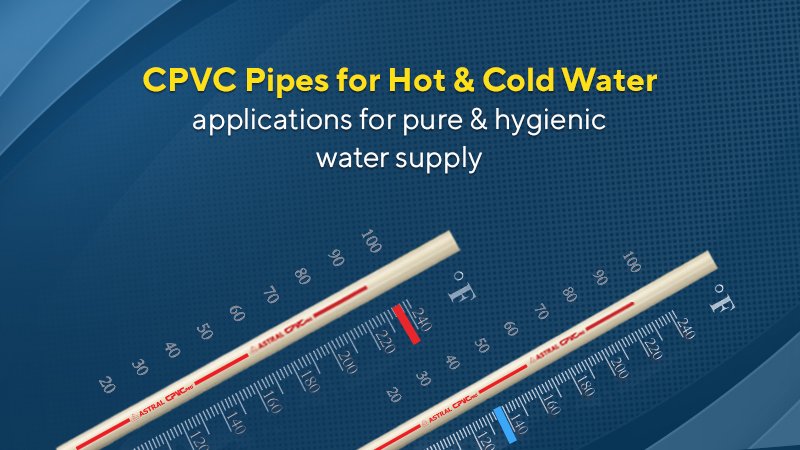General
CPVC Pipes for Hot and Cold Water Applications for Pure and Hygienic Water Supply

Modern lifestyles demand advanced solutions to meet the growing need for a safe, hygienic and reliable water supply. With the increasing use of hot water in daily life, it is essential to use the most suitable materials for plumbing systems. CPVC pipes and fittings offer an excellent option for hot and cold water applications, ensuring you get the purest and most hygienic water supply.
What is CPVC and Why is it Popular for Hot and Cold Water Distribution?
Chlorinated Polyvinyl Chloride (CPVC) is a specially engineered thermoplastic material that can withstand high temperatures and pressure, making it ideal for use in both hot and cold water systems. CPVC is made by adding extra chlorine to PVC, resulting in improved temperature resistance, chemical resistance and durability.
Advantages of CPVC Pipes and Fittings for Safe Water Supply
Astral Pipes was the first to introduce CPVC pipes for hot and cold water distribution in India. The range of products is chemical resistant, corrosion resistant, remains unaffected by chlorine in water and has low thermal expansion and bacterial growth. Astral being the first company to receive NSF approval for its CPVC pipes and fittings speaks volumes about the products’ excellence.
- Temperature Resistance
These CPVC pipes & fittings can withstand high temperatures up to 200°F (93°C), making them an excellent choice for hot water applications. The glass transition temperature (the temperature at which the solid starts to soften and weaken) of CPVC is around 113-115°C, ensuring long-term durability and performance.
Astral CPVC PRO is one of the best CPVC pipes in India, is made from a tough and rigid thermoplastic material meeting cell class DP 110-2-3-2 as per IS 15778, the standard specification for CPVC pipes for hot and cold water supplies.
- Corrosion Resistance
Unlike metal pipes, CPVC pipes & fittings are immune to corrosion, scaling and rust. This ensures a longer lifespan, reduced maintenance costs and improved water quality. These CPVC pipes and fittings are also suitable for a wide range of applications due to their unique molecular structure and high corrosion resistance.
- Chemical Resistance
CPVC pipes are resistant to a wide range of chemicals, including acids, alkalis and salts. This makes them suitable for various applications, including industrial and residential plumbing systems.
Make sure to look for CPVC pipes that are resistant to chemicals and safe to be installed underground. It’s also certified by ASTM D2774 for underground installation of thermoplastic pipes.
- Ease of Installation
CPVC pipes and fittings are lightweight and easy to install, requiring fewer tools and less time compared to metal pipes. If you choose one of the best CPVC brands in India, they are easy to install and require minimal maintenance, making them a cost-effective choice.
- Cost-Effective
Due to their long life, low maintenance requirements and easy installation, CPVC pipes are a cost-effective solution for hot and cold water plumbing systems.
CPVC pipes are available in a variety of sizes and configurations, making it easy to find the right fit for your specific needs. Whether you are a homeowner or a business owner, you can choose CPVC pipes and fittings to ensure the long-term health and safety of the water supply.
Ensure to choose the best CPVC pipes in India that offer superior insulation, fire resistance and durability but also hold prestigious certifications from recognised organisations. The ISI mark and ASTM certifications contribute to the credibility and reliability of the best CPVC pipe brand in India.
By choosing the best CPVC pipes in India for your water supply needs, you can enjoy a clean, pure and safe supply of water.
-

 Tech1 year ago
Tech1 year agoHow to Use a Temporary Number for WhatsApp
-

 Business2 years ago
Business2 years agoSepatuindonesia.com | Best Online Store in Indonesia
-

 Social Media1 year ago
Social Media1 year agoThe Best Methods to Download TikTok Videos Using SnapTik
-

 Technology1 year ago
Technology1 year agoTop High Paying Affiliate Programs
-

 Tech10 months ago
Tech10 months agoUnderstanding thejavasea.me Leaks Aio-TLP: A Comprehensive Guide
-

 FOOD12 months ago
FOOD12 months agoHow to Identify Pure Desi Ghee? Ultimate Guidelines for Purchasing Authentic Ghee Online
-

 Instagram3 years ago
Instagram3 years agoFree Instagram Auto Follower Without Login
-

 Instagram3 years ago
Instagram3 years agoFree Instagram Follower Without Login





















